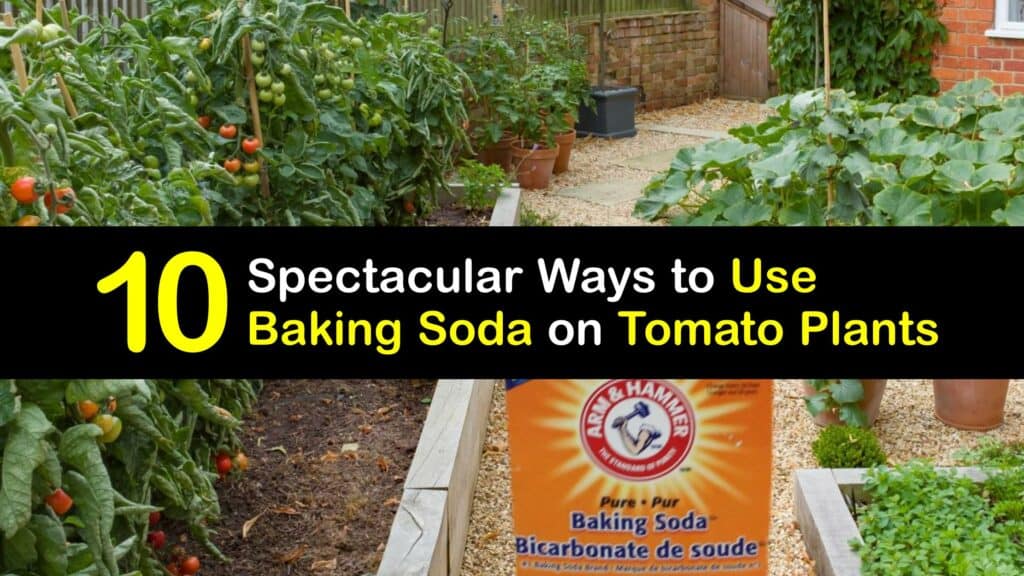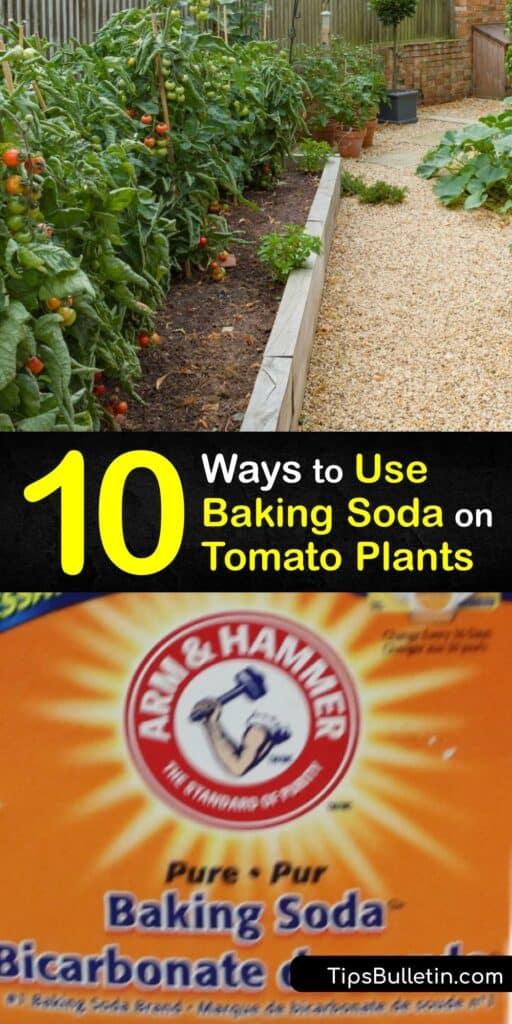There is nothing better than plucking a homegrown tomato straight from the vine and taking a bite of its juicy sweetness, and while growing tomato plants is reasonably straightforward, they need a little help now and then to thrive. Believe it or not, there are various ways to use baking soda for tomatoes, some of which may surprise you.
We look forward to planting tomatoes each year to make homemade tomato sauce and tomato soup, and one of our favorite life hacks for growing tomatoes is baking soda. You may think that the primary purpose of this everyday kitchen staple is to help baked goods rise. However, it is the perfect garden helper for your tomato plant.
Baking soda is a miracle product and a must-have for every home. It’s simple, natural, inexpensive, and has many uses for personal care, health, cleaning, and gardening. It helps plants fight disease, deters pests, amends plant soil, and gives plants a boost of nutrients.

- Ways to Use Baking Soda for Tomato Plants
- What is Baking Soda?
- Is Baking Soda Good for Tomato Plants?
- Using Baking Soda Spray for Tomato Plants to Prevent Blight
- How to Use Baking Soda for Tomatoes to Kill Pests
- Preventing Powdery Mildew on Tomato Plants with Baking Soda
- Combining Baking Soda and Oil to Treat Tomatoes
- Using Baking Soda and Epsom Salt to Feed Tomato Plants
- Testing Tomato Plant Soil pH with Baking Soda
- Use Baking Soda and Aspirin to Treat Tomato Diseases
- Ineffective Tomato Plant Baking Soda Uses
Ways to Use Baking Soda for Tomato Plants
There are so many uses for this product that it’s astounding. If you only have one box of baking soda in the house, you’re missing out. Learn how to use baking soda as part of your tomato plant care routine to ensure your plants produce the healthiest fruits for adding to salads or making soup.
What is Baking Soda?
You probably don’t think twice when scooping a teaspoon of baking soda into a bowl of cake batter. Discover what this powder is, where it comes from, and how it is helpful around the house.
Baking Soda
Sodium bicarbonate, baking soda, is an alkaline powder from soda ash. It is a natural leavening agent that reacts when it comes into contact with acid, producing carbon dioxide, and it’s one of our favorite household products. It’s useful for everything from baking, cleaning, and deodorizing to treating heartburn, relieving itchy skin, and plant care.
Is Baking Soda Good for Tomato Plants?
You know it’s useful for baking, but is baking soda good for tomato plants? Yes, baking soda is terrific for your plants; find out how sodium bicarbonate benefits tomatoes.
What does baking soda do for tomato plants? Since baking soda is an alkaline powder, it prevents and treats fungal diseases by disrupting the balance of fungal cells.

In addition, its alkalinity is great for lowering the soil’s acidity. An excellent form of pest control, the abrasive powder absorbs into the insect’s exoskeleton, causing dehydration.
Using Baking Soda Spray for Tomato Plants to Prevent Blight
Tomato blight is a common disease among tomato plants, systematically destroying the plant’s stems, leaves, and fruits. Make a baking soda spray for tomato plants to eliminate and prevent this fungal infection.
Symptoms of early and late tomato blight occur when the first fruits appear. Early blight produces small brown spots on lower leaves, and late blight causes dark lesions on the outer edges of older leaves. If you see light brown spots on tomato leaves, act quickly to stem the blight.
To prevent tomato blight, combine baking soda and water in a spray bottle, and add a couple of drops of dish soap. Shake the container well, and spritz the baking soda solution on the plant leaves and stems. This treatment creates an unsuitable environment for blight to survive.
If you notice mushy brown bottoms on your tomatoes, you have blossom end rot. Typically, lack of calcium causes tomato rot. It’s best to toss the affected tomatoes.
How to Use Baking Soda for Tomatoes to Kill Pests
Not only is baking soda an excellent tomato fungus treatment, but it’s also helpful for deterring and killing tomato pests, like aphids, cabbage worms, snails, and slugs. Use this powder to eliminate insects from your plants.
Combine water, baking soda, and basil essential oil in a plastic spray bottle, and shake the container well. Spray the liquid over your tomato plants and reapply every few days as a natural insecticide for tomatoes. The baking soda repels and kills insects, while the basil oil helps tomatoes grow.
Preventing Powdery Mildew on Tomato Plants with Baking Soda
While powdery mildew is not as harmful as other fungal diseases, it quickly gets out of control if left unchecked. Fortunately, sodium bicarbonate works well to prevent this plant disease from starting in the first place.
Pour a gallon of water into a large jug and add the baking soda and liquid soap. Stir the ingredients and pour the solution into the spray bottle. Spray the liquid on all parts of your plants on a cloudy day to prevent a fungal attack from mildew.
Combining Baking Soda and Oil to Treat Tomatoes
Is baking soda good for tomato plants that have powdery mildew? If you didn’t use a preventative treatment and your plant already suffers from this disease, combining baking soda with vegetable oil or Murphy’s oil soap will eliminate this fungal disease.
There are two ways to treat powdery mildew on tomato plants. The first way is to combine a tablespoon of baking soda and vegetable oil with a gallon of water. Add a teaspoon of dish soap and shake the container gently to mix.
Another way to use baking soda to treat plants is to mix two tablespoons of Murphy’s oil soap and four tablespoons of baking soda with a gallon of water. Spray your plants with either solution and alternate between them each week to prevent the fungi from developing resistance.
Using Baking Soda and Epsom Salt to Feed Tomato Plants
Baking soda is a natural fungicide and soil amendment, and Epsom salt helps plants produce more fruits. Combine the power of these ingredients to give your tomatoes a boost while eliminating fungal spores. Make a natural fertilizer for tomatoes that is easy and effective.
Combine the water, ammonia, baking soda, and Epsom salt in a large container and stir the ingredients. Allow it to sit for 30 minutes as the salt dissolves, and water your tomato plant as usual. Store the plant food in a cool, dark area and use it to feed your plants once a month.
Some kitchen waste is also good for tomatoes. Use eggshells as homemade calcium for tomato plants or add coffee grounds and banana peels for added nutrients.
Testing Tomato Plant Soil pH with Baking Soda
Tomato plants love growing in acidic dirt, and baking soda and white vinegar are great tools for testing the soil pH for tomato plants. Here is how to test your planting area quickly to learn whether you have alkaline or acidic soil.
Take a soil sample from the area where you plan on growing a tomato plant by scooping the dirt into a small cup. Pour a half cup of distilled vinegar into one of the samples and check to see if it bubbles. If there is no bubbling action, you have acidic soil.
Take another dirt sample and pour a tablespoon of baking soda and half a cup of water into it. It has a soil pH of 7 or lower if you notice bubbles.
Use Baking Soda and Aspirin to Treat Tomato Diseases
While baking soda is a natural fungicide for tomatoes, sometimes it needs a little help to be more effective. Combine sodium bicarbonate with aspirin from your medicine cabinet to make a baking soda spray for tomato plants.
Pour the water into a large container and add baking soda and crushed aspirin tablets. Stir the solution and let it sit for a few minutes to allow the soda and aspirin to dissolve. Pour the liquid into a bottle and spray your plant from top to bottom to stop fungus growth and disease.
Ineffective Tomato Plant Baking Soda Uses
Baking soda has more uses than we can count, but it’s not a cure-all. Discover baking soda uses that don’t work so that you don’t waste your time and energy.
You may have heard that alkalinity increases the sweetness of tomato fruits. This is one of the most common misconceptions about using baking soda for tomatoes since the acidity of the soil doesn’t play a significant role in tomato sweetness. For sweeter tomatoes, consider planting plum or cherry tomatoes.
Some think that adding sodium bicarbonate to the dirt helps plants flower, especially if they suffer from a sodium deficiency. However, applying too much baking soda causes a micronutrient imbalance and may kill your plant.
Finally, many believe that baking soda kills weeds. While this is true, adding too much of this powder impacts your plants negatively, and it’s better to pull the weeds by hand.
A fresh tomato is far better than canned tomatoes for making homemade sauce or a tomato soup recipe, and using baking soda in the garden helps plants produce delicious tomatoes that are pest and disease-free. Sprinkle baking soda over the soil or make a baking soda spray and watch your plants flourish.

Now that you’ve learned how to use baking soda for tomatoes to promote healthy plant growth, why not share our baking soda and tomato plant guide with your gardening friends and family on Pinterest and Facebook?